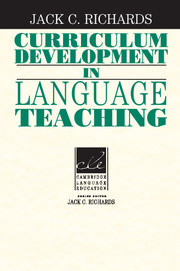Book contents
- Frontmatter
- Contents
- Series editor's preface
- Preface
- Credits
- 1 The origins of language curriculum development
- 2 From syllabus design to curriculum development
- 3 Needs analysis
- 4 Situation analysis
- 5 Planning goals and learning outcomes
- 6 Course planning and syllabus design
- 7 Providing for effective teaching
- 8 The role and design of instructional materials
- 9 Approaches to evaluation
- Author index
- Subject index
9 - Approaches to evaluation
Published online by Cambridge University Press: 03 May 2010
- Frontmatter
- Contents
- Series editor's preface
- Preface
- Credits
- 1 The origins of language curriculum development
- 2 From syllabus design to curriculum development
- 3 Needs analysis
- 4 Situation analysis
- 5 Planning goals and learning outcomes
- 6 Course planning and syllabus design
- 7 Providing for effective teaching
- 8 The role and design of instructional materials
- 9 Approaches to evaluation
- Author index
- Subject index
Summary
A recurring theme throughout this book has been reflective analysis of the practices that are involved in planning and teaching a language course. This has involved an examination of the context in which the program occurs, of the goals, syllabus, and structure of a course, and how these can be planned and developed, as well as analysis of the teaching and learning that takes place during the course. The focus throughout has been analysis of the different factors that determine the successful design and implementation of language programs and language teaching materials. This overall and interlinked system of elements (i.e., needs, goals, teachers, learners, syllabuses, materials, and teaching) is known as the second language curriculum. However, once a curriculum is in place, a number of important questions still need to be answered.
These include:
• Is the curriculum achieving its goals?
• What is happening in classrooms and schools where it is being implemented?
• Are those affected by the curriculum (e.g., teachers, administrators, students, parents, employers) satisfied with the curriculum?
• Have those involved in developing and teaching a language course done a satisfactory job?
• Does the curriculum compare favorably with others of its kind?
Curriculum evaluation is concerned with answering questions such as these. It focuses on collecting information about different aspects of a language program in order to understand how the program works, and how successfully it works, enabling different kinds of decisions to be made about the program, such as whether the program responds to learners' needs, whether further teacher training is required for teachers working in the program, or whether students are learning sufficiently from it.
- Type
- Chapter
- Information
- Curriculum Development in Language Teaching , pp. 286 - 310Publisher: Cambridge University PressPrint publication year: 2001
- 2
- Cited by

